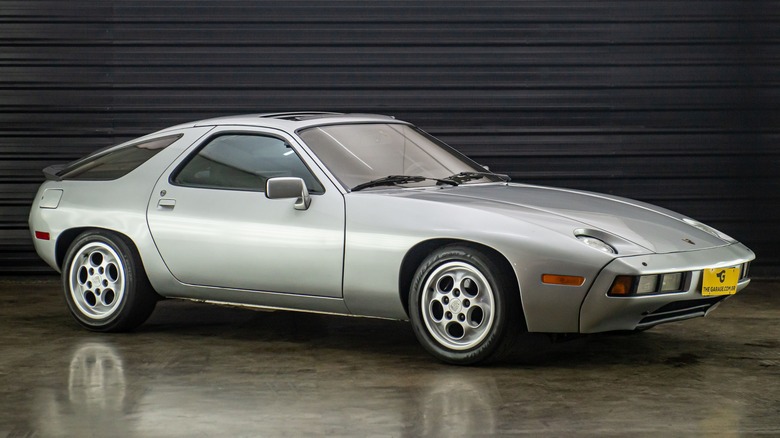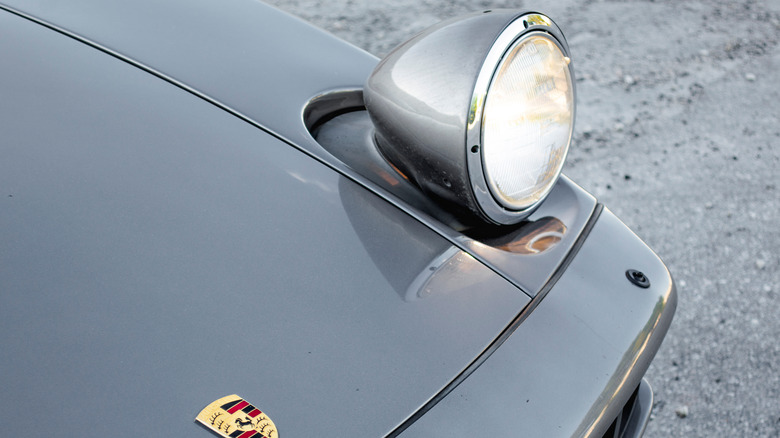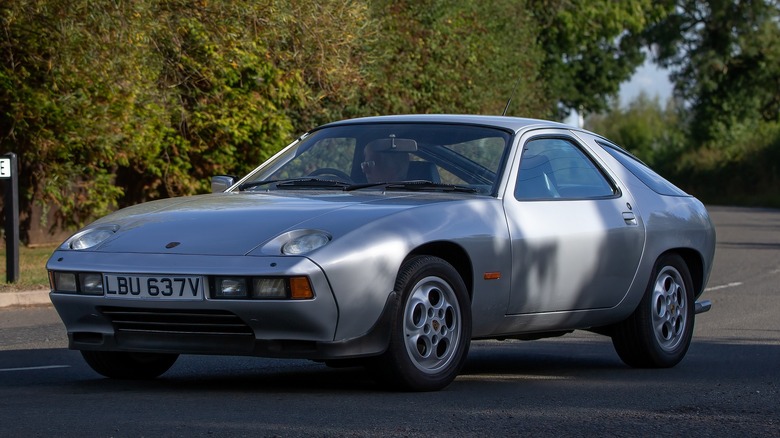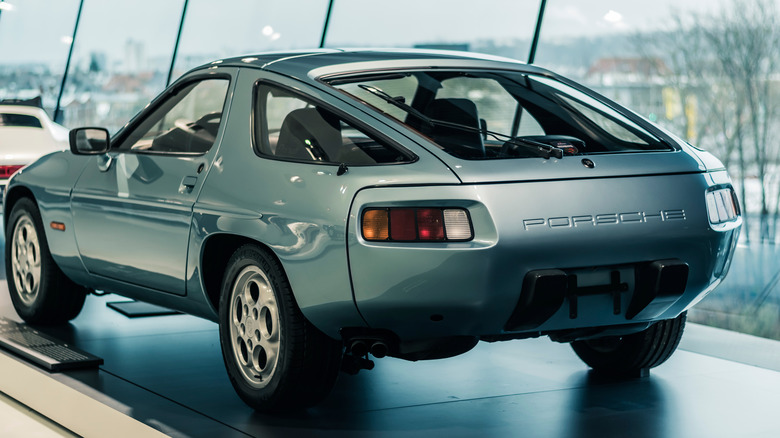Why The 928 Is The Most Underrated Porsche Of All Time
Challenge yourself to think of the greatest Porsches of all time and, unlike Ferrari's back catalog packed with front-engined masterpieces and a strange naming convention, your brain will likely serve up a lot of rear-engined 911s. Perhaps a mid-ship Carrera GT or Cayman GT4 RS, too. It's time to disrupt this mindset and look at Porsche's great but often overlooked front-engined sports car, the Porsche 928.
Launched in 1977 and in production until 1995, the Porsche 928 was originally intended to replace the company's iconic 911 as the new flagship — but instead of being an air-cooled, rear-engined sports car, the 928 was a front-engined, water-cooled luxury grand tourer designed to soak up the miles at great speed.
Porsche says that a focus on lightweight construction "saw the extensive use of aluminum for the body panels rather than traditional sheet steel." Aluminum was used in the doors, front fenders, and hood, saving a claimed 77 pounds, according to Stutt Cars, and it also appeared behind the integrated front bumpers, giving the car a cleaner, modern look while also protecting it from low-speed impacts.
Pop-up headlights
Key to the 928's look is its pop-up headlights. Instead of flipping upward on a mechanism that rotates backward like those of a Ferrari 365 GTB/4 or early Mazda Miata, the Porsche's rotate forward like those of a Lamborghini Miura. This means the lamps themselves are always on display, then sit up when illuminated and in use. This lamp design remained throughout the car's lifetime, including the second-generation 928 S (model years 1980 to 1986) and 928 S4 (model years 1987 to 1991), until production ended in 1995.
Another key 928 design detail was the rounded fastback, dominated by a large rear windshield and flanked by a pair of side windows for improved cabin lighting and over-the-shoulder visibility. The ample glasshouse also meant plenty of light for the rear passengers who, as in a 911, were accommodated by a pair of narrow but deep seats.
Far from an afterthought for families, the rear seats were intended to be used. The car was designed to provide sun visors for rear passengers, and the optional extras list included air cooling for the rear cabin, and even for the glove compartment. Other luxuries included power windows, central locking, and cruise control.
Sports car performance
The first-generation 928 was well-received by the motoring press, and awarded Car of The Year for 1978, from which the jury described the Porsche as "an outstanding car likely to replace the technically decaying 911. The obsolete points of the veteran were overcome with a front engine, water cooling, noise suppression, good weight balance and a road attitude that made fast driving much easier and more predictable."
Although the 928's design seems fairly conservative by today's standards — and even compared to fellow sports cars of the '70s and '80s it lacked visual eccentricity — it was built as a true performance car. The first generation was powered by an all-new 4.5-liter V8 engine producing 240 horsepower.
The second version, called the 928 S, introduced black front and rear spoilers, and side protection strips in body color. Engine displacement was increased to 4.7 liters and power grew to 300 horsepower, then to 310 horsepower in 1984. This fell to 288 horsepower for 1986 despite engine capacity growing to 5.0 liters due to the addition of a catalytic converter. Finally, the 928 S4 arrived in 1987 and featured a new, rounded front apron with air intakes, and a black rear wing that sprouted away from the body between the flush-fit tail lights, Porsche explains. Engine capacity remained at 5.0 liters but power was increased to 320 horsepower.
A 'grown-up supercar' and movie star, too
Autocar magazine said of the 928 in October 1978: "It is remarkable how well the car rides. The 928 combines performance, practicality and the safest of road manners to a degree unmatched by any other supercar. You could call the 928 a grown-up supercar." And, while it might not have the kudos of James Bond's Aston Martin DB5 or Lt. Frank Bullitt's Ford Mustang, the Porsche 928 is also a car to have graced the silver screen. An example appeared in 1983's "Risky Business," a movie in which it was driven by high school student Joel Goodsen, played by Tom Cruise.
Finished in platinum metallic with a cork interior, the 1979 Porsche 928 driven by Cruise was sold for $1,980,000 at auction in 2021. That price, as Hagerty points out, was about 47 times higher than a "best in the world" 928 would be expected to achieve, minus its movie star credentials. It is also claimed to be the very car in which Cruise learned to operate a manual transmission.
Today, prices range from $7,500 for an example described as being in "project" condition, to around $30,000 for a "mint" example and $89,000 for a 928 with just 16,000 miles on the clock. Expect to pay more than $400,000 for the ultra-rare 928 GTS from 1995, of which just 26 of the 2,900 examples produced came to the U.S. market with a manual gearbox. That variant has a 5.4-liter V8 producing 350 horsepower, uprated brakes, and unique wheels.



